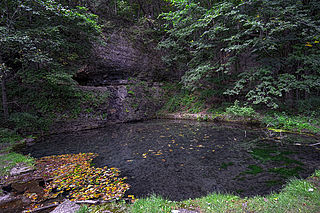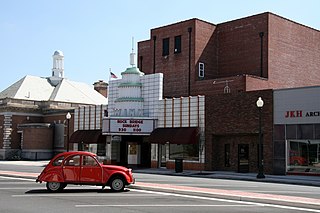
Schenley Park is a large municipal park in Pittsburgh, Pennsylvania. It is located between the neighborhoods of Oakland, Greenfield, and Squirrel Hill. It is also listed on the National Register of Historic Places as a historic district. In 2011, the park was named one of "America's Coolest City Parks" by Travel + Leisure.

Maquoketa Caves State Park is a state park of Iowa, United States, located in Jackson County. It stands northwest of the city of Maquoketa. In 1991 111 acres (45 ha) on the east side of the park were listed as a historic district on the National Register of Historic Places.

Lake Murray is a 5,700-acre (23 km2) lake in south central Oklahoma, near Ardmore named for Oklahoma Governor William H. Murray. It was created by damming Anadarche and Fourche Maline Creeks. The lake is wholly within Lake Murray State Park, Oklahoma's largest state park, containing over 12,500 acres (51 km²) of relative wilderness. A state-operated lodge and resort is located on the west shore that serves many visitors to the lake, and serves as a base for numerous cabin and campground facilities near the lake.

Scenic State Park is a Minnesota state park near Bigfork in Itasca County. It encompasses 3,936 acres (1,593 ha) of virgin pine forests that surround Sandwick Lake and Coon Lake. It also includes portions of Lake of the Isles, Tell Lake, Cedar Lake, and Pine Lake. Established in 1921, the Ojibwe tribe had previously used the area for hunting. The park has places for camping, hiking, swimming, fishing, and canoeing.
The Snake River Ranch, near Wilson, Wyoming, is the largest deeded ranch in the Jackson Hole area. The ranch buildings are grouped into three complexes comprising headquarters, residential and shop complexes. The ranch combined two neighboring homesteads and was first owned by advertising executive Stanley B. Resor and his wife, Helen Lansdowne Resor. The Resors used the property as a vacation home, but the ranch was also a full-time, self-sustaining operation.

Backbone State Park is Iowa's oldest state park, dedicated in 1919. Located in the valley of the Maquoketa River, it is approximately three miles (5 km) south of Strawberry Point in Delaware County. It is named for a narrow and steep ridge of bedrock carved by a loop of the Maquoketa River originally known as the Devil's Backbone. The initial 1,200 acres (490 ha) were donated by E.M. Carr of Lamont, Iowa. Backbone Lake Dam, a relatively low dam built by the Civilian Conservation Corps (CCC) in the 1930s, created Backbone Lake. The CCC constructed a majority of trails and buildings which make up the park.

Edwin Warner Park and Percy Warner Park, collectively known as Warner Parks, are two major public parks in Nashville, Tennessee. They are part of the park system managed by the Metropolitan Board of Parks and Recreation of Nashville and Davidson County. Percy Warner Park's front entrance is located at the end of Belle Meade Boulevard. The parks are listed on the National Register of Historic Places as Warner Park Historic District. The district is primarily within Nashville along the southern edge of Davidson County, Tennessee, but it extends into Williamson County, Tennessee as well.

The Gasparilla Inn & Club is a historic hotel at 500 Palm Avenue on Gasparilla Island in Boca Grande, Florida.

Dalton Commercial Historic District is a historic district in Dalton, Georgia that was listed on the National Register of Historic Places (NRHP) in 1988. Its boundaries were expanded in 2006.

The Keweenaw Mountain Lodge and Golf Course Complex is a resort located near Copper Harbor, Michigan. It was designated a Michigan State Historic Site in 1976 listed on the National Register of Historic Places in 1970, and open to the public.

Grand Forks County Fairgrounds WPA Structures is a collection of five structures within the Grand Forks County Fairgrounds in Grand Forks, North Dakota, that were listed on the National Register of Historic Places in 2009.

The Edmundson Park Historic District is a nationally recognized historic district located in Oskaloosa, Iowa, United States. It was listed on the National Register of Historic Places in 2007. At the time of its nomination it contained 52 resources, which included four contributing buildings, six contributing sites, 19 contributing structures, and three contributing objects. There were also 13 non-contributing buildings, five non-contributing sites, and two non-contributing structures.

Lacey-Keosauqua State Park is located southwest of Keosauqua, Iowa, United States. The park is located along the Des Moines River in Van Buren County. First dedicated in 1921, it is the largest state park in size in Iowa. In 1990, three areas were named nationally recognized historic districts and listed on the National Register of Historic Places.
The Iowa Lakeside Laboratory Historic District is a nationally recognized historic district located north of Milford, Iowa, United States. It was listed on the National Register of Historic Places in 1991. At the time of its nomination it contained 33 resources, which included 11 contributing buildings, one contributing structure, and 21 non-contributing buildings. The historic district is part of a campus that provides science classes and research opportunities for university students.

Wildwood Park Historic District is a nationally recognized historic district located in Charles City, Iowa, United States. It was listed on the National Register of Historic Places in 1998. At the time of its nomination it consisted of 26 resources, which included three contributing buildings, one contributing site, nine contributing structures, one contributing object, seven non-contributing buildings, and five non-contributing structures.
The Foster Park Historic District is a nationally recognized historic district located in Le Mars, Iowa, United States. It was listed on the National Register of Historic Places in 2008. At the time of its nomination the district consisted of 237 resources, including 166 contributing buildings, one contributing site, 65 non-contributing buildings, one non-contributing structure, and four non-contributing objects. The district comprises ten full blocks and nine half blocks. The historic buildings are houses and their attendant garages, carriage houses, or barns. The houses are between one and 2½-stories and are composed of frame, brick or stucco construction. For the most part they were built between the 1880s and the 1930s. Architectural styles include the revivals styles of the Late Victorian era to the Colonial Revival and American Craftsman styles of the early 20th century. Sioux City architect William L. Steele has several commissions in the district, as do other architects. Foster Park was established on one of the blocks along Central Avenue. It became a focal point for the neighborhood.

Wapsipinicon State Park is located south of Anamosa, Iowa, United States. The 394-acre (159 ha) park is along the sandstone and limestone bluffs of the Wapsipinicon River, from which it derives its name. It is one of the oldest state parks in Iowa, and it was listed as a historic district on the National Register of Historic Places in 2014.

East Park is a recreational park located in Mason City, Iowa, United States. It was listed as a historic district on the National Register of Historic Places in 2014. At the time of its nomination it contained 21 resources, which included three contributing buildings, one contributing site, five structures, seven non-contributing buildings, and five non-contributing structures. It contains 57.6 acres (23.3 ha) of land along the Winnebago River. The park features picnic areas, a 9-hole disc golf course, three tennis courts, volleyball court, basketball courts, fishing, a sledding hill, playgrounds including the Prairie Playground, a 2.08-mile (3.35 km) hard surface trail system, a band shell and a gazebo.
Fred Maytag Park is a public park located in Newton, Iowa, United States. It was listed as a historic district on the National Register of Historic Places in 2010. At the time of its nomination it contained 39 resources, which included seven contributing buildings, nine contributing sites, eight contributing structures, four contributing objects, four non-contributing buildings, two non-contributing sites, three non-contributing structures, and two non-contributing objects. The park was a gift from F.L. Maytag, founder of the Maytag Company, to the people of Newton. It is significant as an example of a privately funded public park during the Great Depression. The 40-acre (16 ha) partial of land was acquired by Maytag in 1935. It had previously served as the fairgrounds owned by the Jasper County Agricultural Society. He made an agreement with the city council that the park would be privately owned and operated, but open for public use. The city was required to provide water and electricity. It remained a privately owned park until 1977 when it was conveyed to the city.

Prentis Park is a city park in Vermillion, South Dakota. It is a rectangular 20-acre (8.1 ha) park located on the block bounded by Plum Street, Main Street, Clark Street, and Prentis Avenue. It was listed on the National Register of Historic Places in 2001.



















